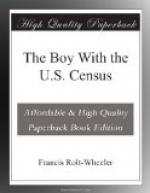“And there’s ten acres of swamp land that ye couldn’t improve unless ye built it on piles,” the farmer said.
“I’ll have to refer that to the Reclamation Service, I guess,” the boy answered, “anyhow for the time we’ll just call it ‘unimproved’ and let it go at that.”
The next few questions passed off without a hitch, but an inquiry concerning the number of animals born on the place during the year was like opening the flood-gates of a dam. If Meacham had been as good a farmer as a yarn-spinner there would have been no question as to his success, for he had some story to tell about every yearling on the place, and they were inimitably told. It was with great reluctance that Hamilton found himself obliged to head off the man’s eloquence and make him stick to hard facts. An inquiry as to the number of eggs sold was somewhat of a puzzle, but the farmer’s wife knew the amount of the “trade” she had received at the grocery store in the nearest town in return for eggs, and at an average sale price of nine cents a dozen, this was easily computed. She was also the authority on the amount of butter made and sold, and on the garden truck.
The business man of the house was a twelve-year-old boy. Not far away, a neighbor had forty acres in clover and some fruit trees, and knowing the value of bees for pollinating the fruit, he was glad to have this boy keep six hives near the orchard and field. A good share of the honey had gone to the neighbor, and the family themselves had used all they wanted, but still the boy’s profit for what he had sold amounted to sixty dollars. He was keen to have Hamilton enter him on the schedule as an independent apiarist on his own account, but Hamilton pointed out to him that a $250 farm was the smallest one allowed to be listed.
This low limit was almost reached the next day when Hamilton found himself on a peanut farm for the first time. He had always known that peanuts, unlike all other “nuts,” grew underground but he had made the common mistake of supposing them to grow on the roots of the peanut plant like the tubers of a potato, instead of really being a true nut, developing from a flower the elongation of the lower portion of which reaches to the ground. The farm was run by an orphaned colored girl nineteen years old and her four younger brothers.
[Illustration: ON A PEANUT FARM. Caesar and his sister at work when Hamilton came to take the census.]
“Jes’ as soon as the young-uns gits big enough,” she said to Hamilton, when discussing the statistics of her little holding, “we’re goin’ to buy a big patch o’ peanut land. Ah’d like to grow peanuts every year, but these hyar gov’nment papers say yo’ shouldn’t. They say once in every fo’ years is enough fo’ peanuts, but Ah’m goin’ to try it every other year.”
“Aren’t they a very troublesome crop?”




